If there was a simple answer to the question of 'who has the best wireless coverage?', it would make choosing a wireless carrier so much easier.
Unfortunately, although the advertising claims as 'the best coverage' and 'best network' pop up from time to time, these claims are just that - advertising claims. There are three sources to reference when looking at independent wireless coverage/network reporting. And, a carrier will typically just reference just one of these source in their ads (in very small font) in a report which favours their network. Also, they may reference only one part of the report to make their claims, like 'We have the #1 network for cell phone calls' whilst being the worst for data at the same time in the same report.
Across all three independent sources, there is no definitive winner.
More Than Maps
In this article, we looked at the current network ratings companies and we looked at the independent collation of carrier maps. To add to this, we looked at the real world experience as compared against the theoretical experience (carrier maps show theoretical coverage). Also, if you are reading this and your experience with your carrier is awful, remember that the age of your phone really matters. The fundamental rule with the carrier's 'great' coverage claimed in their advertising is that if a carrier is promoting their shiny fast new network upgrades, you have to have the latest phone to experience the upgrade benefit. A phone from 5 years ago won't give you access to the new network upgrades and new coverage.
Sources for Wireless Coverage Ratings
There are three key sources of wireless coverage information beyond the carriers themselves.
Carrier maps are plotted in computer software and they are theoretical . Carriers plot their tower locations and run a simulation of how the signal from their towers will travel based on the tech they have installed on each tower. They use an algorithm to plot their total theoretical coverage and display this in their national maps.
Conversely, these independent 'coverage' reports will track and compare wireless coverage in the real world beyond the carrier maps. These companies publish reports annually, and award a winner.
These authorities on wireless coverage include:
- RootMetrics
- OpenSignal
- and to a lesser extent, PCMag (speed tests in 32 cities)
To get their results, these testers use a combination of:
- Drive tests - literally driving around cities with multiple phones constantly testing the network and compiling results.
- Background network data - when you do a speed test, the speed test will be checking which network you are on, how fast your connection is, and where you are located for the test. Ookla (speedtest.net) now owns RootMetrics and this speedtest.net information helps RootMetrics with the sample size in their reports. There are many sources for background data.
- Crowd sourced data - OpenSignal use crowd sourced data from users who have installed the OpenSignal app on their phones. This app runs in the background, providing real world results in all the locations the user visits.
RootMetrics
RootMetrics has the most rigorous testing program and twice a year, they release a report which tallies up their results across the cities in which they tested. In the most recent report for 2022, AT&T scored most consistently across their metrics. However, in 2021, Verizon scored more highly and the 2022 report saw Verizon and AT&T pretty evenly matched.
The RootMetrics reports are judged on overall performance, reliability, accessibility, speed, data, calls and text.
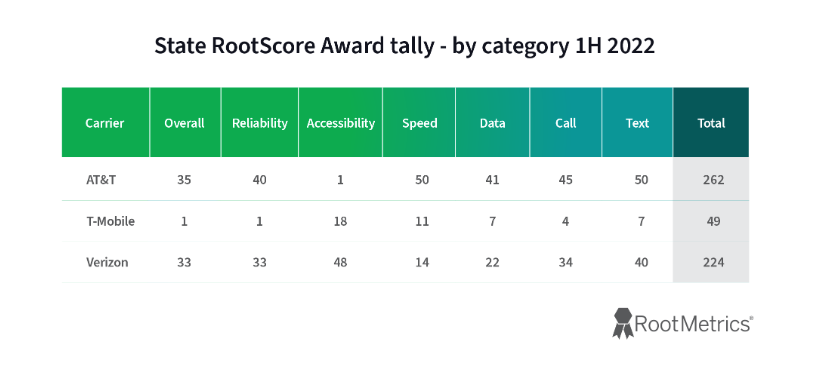
RootMetrics sells their drive test data to carriers so that they can see real world experience in each city (including dead zones) and the results are trusted by carriers.
OpenSignal
OpenSignal relies on user data from installations of their OpenSignal app to track real world coverage by running background tests on their customer's phones in the real world to compile data on network coverage and performance. The company has more than 10 million downloads of their app for Android alone (iPhone download numbers are not shown).
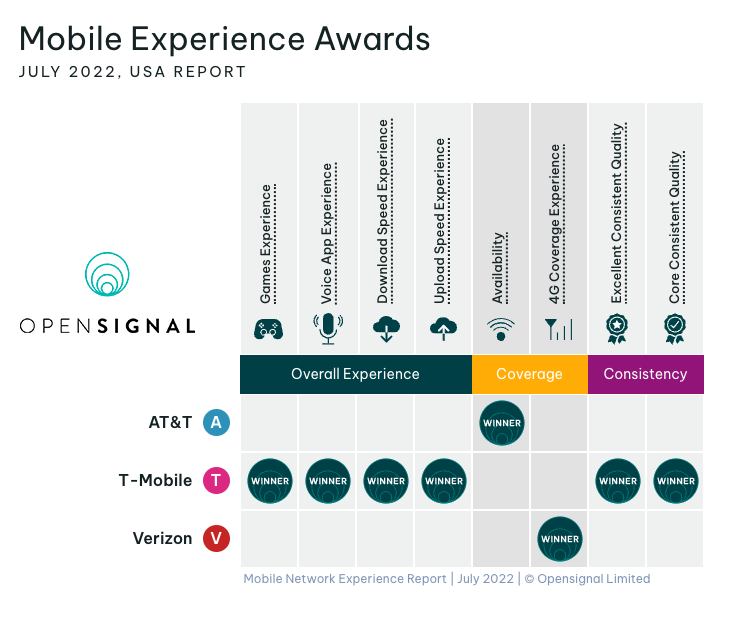
OpenSignal compiles the data from the hundreds of millions of background tests from their users and gave the most awards to T-Mobile in 2022.
PCMag
Lastly, PCMag does an annual speed test across a number of cities (32 cities) using a drive test methodology.
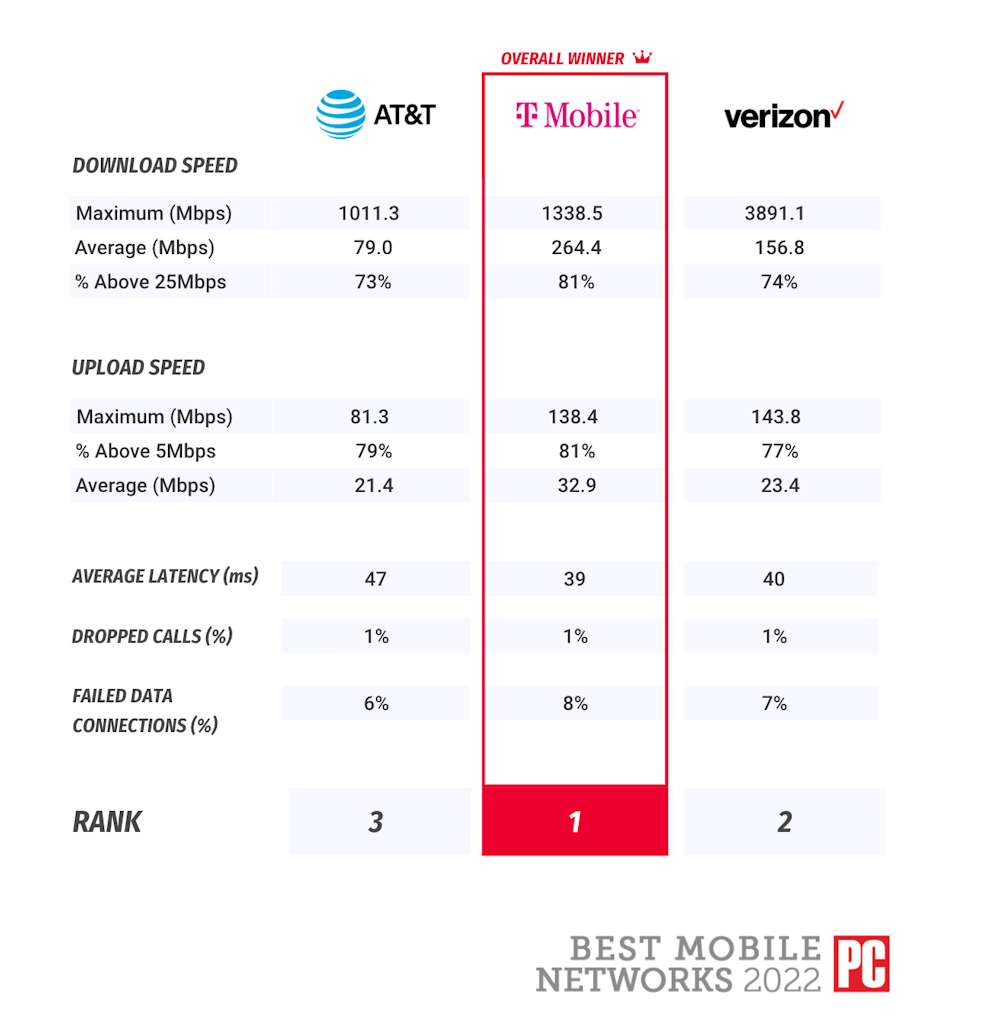
Conclusive Winner for Best Wireless Coverage?
When the results of OpenSignal, RootMetrics and PCMag are tallied, there is no clear winner.
- In 2021 Verizon was the RootMetrics H1 winner.
- In 2022 AT&T was the RootMetrics H1 Winner.
- In 2022 T-Mobile won the overall score from OpenSignal and PCMag for speed.
| Source | 2021 Overall Winner | 2022 Overall Winner | Source |
| RootMetrics | Verizon | AT&T | 2022 | 2021 |
| OpenSignal | Mixed | T-Mobile | 2022 | 2021 |
| PCMag | T-Mobile | T-Mobile | 2022 | 2021 |
| Conclusion | Mixed results | Mixed results |
From the testing sources, there is no clear definitive winner when it comes to coverage and network experience. Carriers are very precious and protective about their network ratings, a fact which can be seen in the way that RootMetrics is careful to show their results in alphabetical order rather than splashing the name of their winner at the top of the page and declaring it an open and shut case.
For customers to get the best wireless coverage experience in their own city, RootMetrics provide results per city from their driving research. These city scores provide the most reliable data from actual testers on a broad basis across the country. The OpenSignal maps also show real world data and can help you look at the locations you visit most often.
What is Wireless Coverage/Network Experience?
Without an obvious #1 ranking, the natural question to ask is 'why is it so hard to find a clear winner?'.
The topic of 'best wireless coverage' is too subjective to allow for a definitive answer. A network may excel in one area like sheer breadth of coverage, but the same network may be flakey and slow when it is actually used.
When a carrier makes a claim like they are the 'best', 'fastest' or 'most reliable', they typically reference one of the categories of coverage scoring, and not a comprehensive win in all the important categories.
To hold the claim as having the 'best coverage', the winner must be superior in all, or the majority, of key coverage and network categories.
The central characteristics to rate a wireless carrier are as follows:
Square Miles of Geographical Wireless Coverage
This metric can simply be summed up by the old advertising claim of AT&T with their campaign ‘more bars in more places’. When scoring this category the judging is simple - if a carrier covers more square miles than their competitors, they have the widest coverage.
The results area are measured in land mass covered (square miles) and Verizon and AT&T both have the largest footprint of any carrier in the US. This can be seen in this simple comparison below.
However, this can not be the only factor in judging a network as coverage in remote areas is not important to the day to day experience for the majority of American consumers. Additionally, some wireless networks have been built out in the past so that they are 'wide reaching', but they are also 'thin' and the performance is weak. 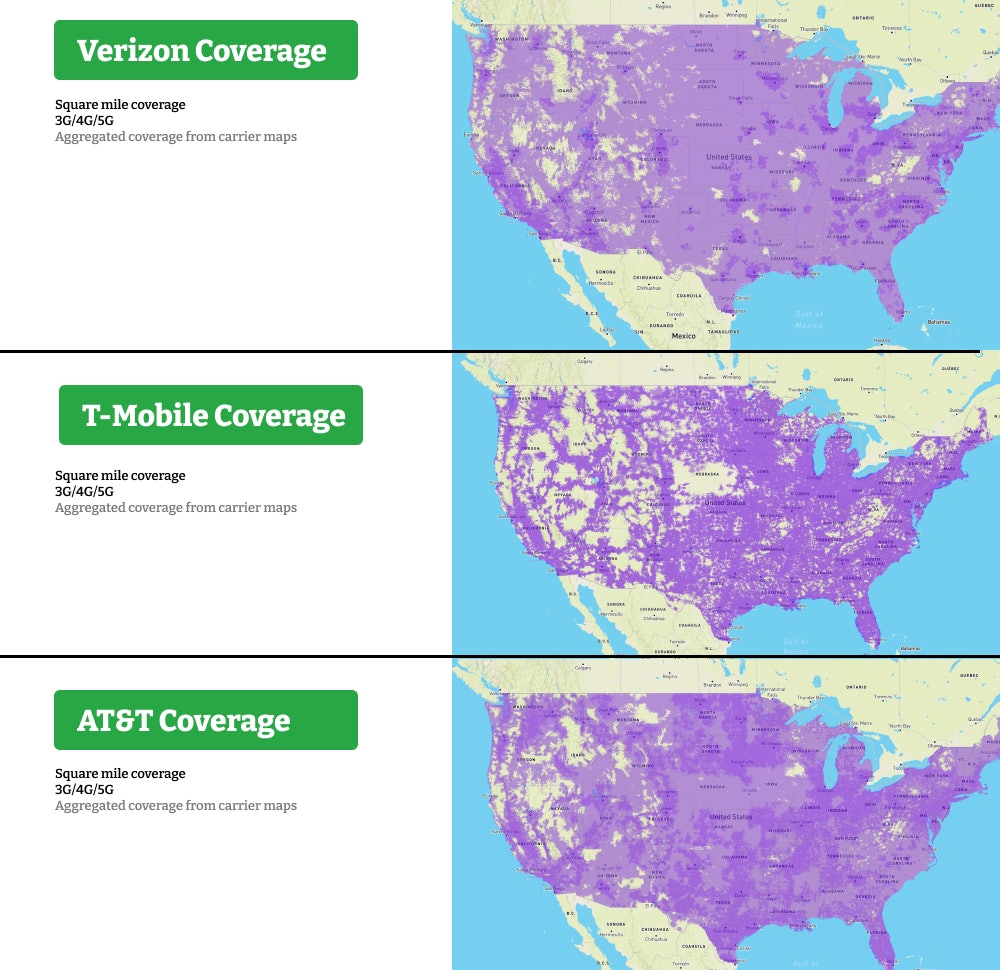
Coverage in all the Places Where People Actually Live
Whilst the sheer size of coverage and square miles of coverage is a clear scoring mechanism, coverage claims became more contentious when T-Mobile began to focus their coverage claims on the places where people actually live, rather than expansive miles of coverage in wide open ranges and farmlands.
Therefore, in 2015 T-Mobile started to claim they had 95% of the US covered (305 million Americans). However, when they made that claim, they referenced ‘pops’ which is to say that they had coverage where 95% population lives - not 95% of the land area of the US.
Is this false advertising? Not at all, they do say ‘pops’ in their advertising and for almost all wireless subscribers, they are more concerned about their strength of the coverage around their home and surroundings than theoretical coverage of a farmland in Idaho.
T-Mobile might claim 95% of the US covered but when they do, they reference ‘pops’ which is to say that they have their coverage focussed on where 95% population lives, and not 95% of the land area.
Speed
Beyond the geographical coverage in your city or town, the next thing consideration is the speed of the wireless network. Far reaching and wide coverage is useless if it does not provide a compelling internet experience. To understand real world speed experience, it is important to look at the tests from RootMetrics and OpenSignal and not just look at the carrier maps. Additionally, if you are looking for 5G you must have a 5G compatible phone that is best matched for the network you are using. The PCMag results have a focus on speed.
Congestion
Finally, in determining who has the best coverage, the congestion and throughput on the network is truly important. There is no use to a network if it is fast in theory, but totally jammed with users in real life. When there are too many users on a thin network, the network can slow to a crawl.
The throughput and capacity of a network can make or break the real world usefulness of tremendous geographical coverage. If you have been to a football game or live event, you will know how bad the the experience can be when there are too many people on the network in a single location.
Conclusion
With all of these things in mind, the unfortunate answer is there is no definitive winner when it comes to the official #1 for coverage and network experience. One carrier does not win in every single category and every single city from every single source.
In fact, it is more helpful for a shopper to research their own city rather than on a national level. The hard truth is that word ‘best’ is completely subjective when it comes to wireless carriers. There’s no doubt that coverage matters, but your location and phone is the most important factor and the advertising claims on TV can't be relied on to determine your experience.
Your Phone Matters for Cell Phone Coverage
If you are familiar with 3G, 4G and LTE then will be aware that 5G is the next upgrade in this cycle of network improvements for wireless carriers.
Each year, phone manufacturers and carriers work together on the frequencies to support.
Therefore, if your phone is five years old, your carrier might say they have an excellent network, and they might, but the chances are you won't have the best experience -- your phone won't support the best new parts of their network build out.
As an example, the iPhone 11 does not support 5G from any US carrier so if you are seeing commercials for 'blazing fast' network experiences on your carrier and you still use an iPhone 11, you won't see any change in your experience. And, over time, your experience will likely degrade as carriers support new frequencies but the antennas in your old phone will not.
A 2G phone from many years ago is no faster today, even though the networks are much faster.
To further complicate this, specific sub-variants of phones are used to match with carrier's frequencies. An iPhone sold by T-Mobile will be best batched to all of T-Mobile's frequencies and network specs whilst an iPhone sold in another country will be best matched to the carrier frequencies there. An iPhone from overseas won't be as good on T-Mobile as the iPhones matched to T-Mobile. Not all iPhone 14 Pro models are the same. An iPhone 14 Pro will have a sub variant number such as as shown by Apple here.
For example, the iPhone 14 sub variants are Model A2892, Model A2891, Model A2890, Model A2889, Model A2650 where each sub variant has different networks to support based on the 5G and LTE bands used by that carrier.
Although there is a general support for most phones across most networks on a broad scale, there are specific frequencies which might be missing, preventing on iPhone user with an imported iPhone from having the same network experience as an iPhone sold by the carrier in the USA.
If you don't feel like your experience with a carrier matches their promises, you can only make a fair assessment if you are testing it with the latest and greatest technology.

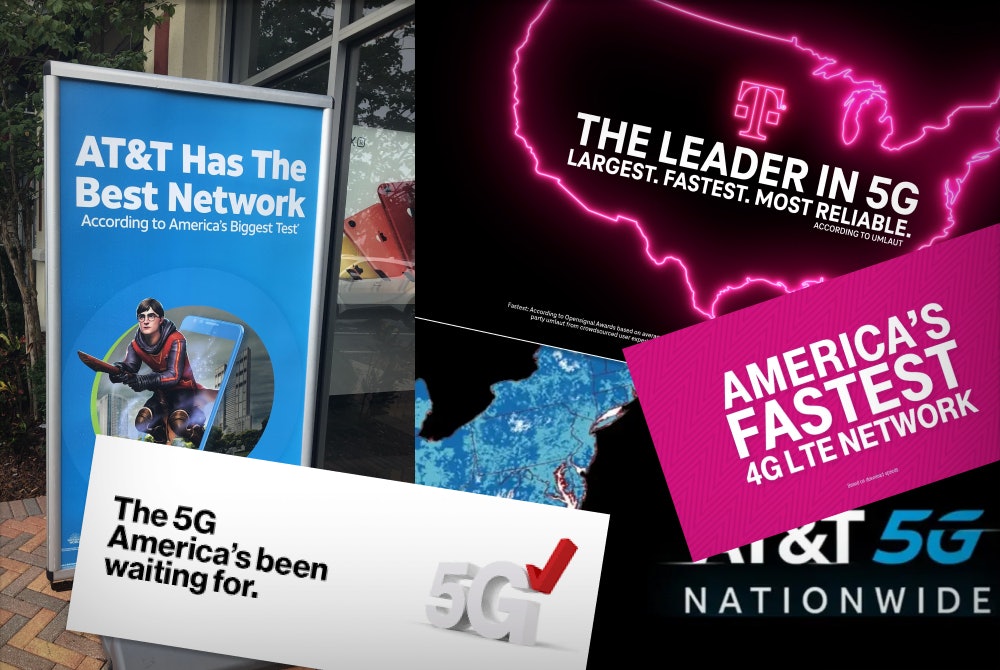
Comments